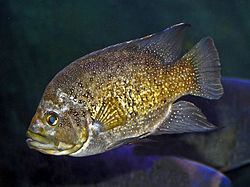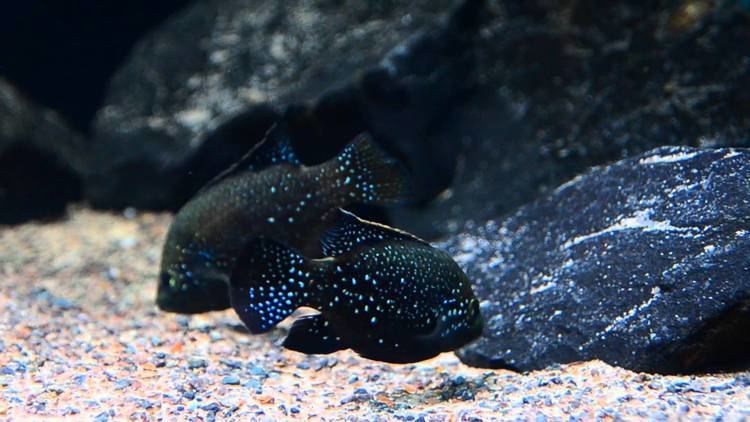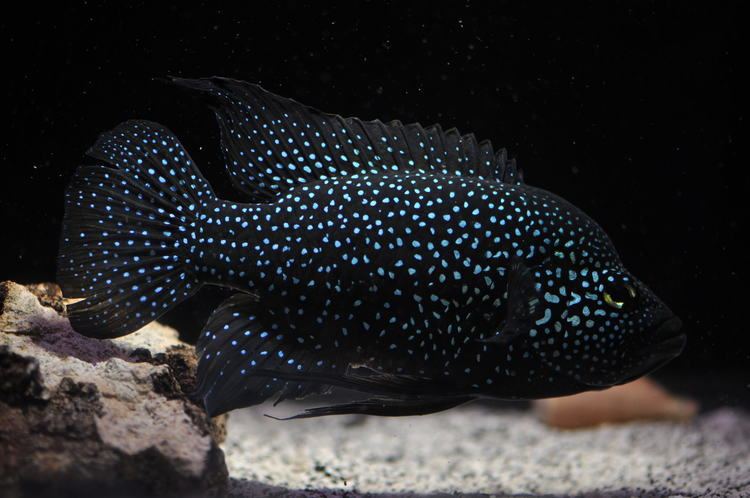Order Perciformes Higher classification Paratilapia | Phylum Chordata Scientific name Paratilapia polleni Rank Species | |
 | ||
Similar Cichlid, Pseudotropheus saulosi, Paretroplus, Paretroplus menarambo, Ptychochromis | ||
Madagascar cichlid paratilapia polleni
Paratilapia polleni is a medium-sized cichlid endemic to Madagascar. It is also a popular fish for display at public aquaria.
Contents
- Madagascar cichlid paratilapia polleni
- Paratilapia polleni pre spawning dance
- Morphology
- Habitat and behavior
- In the aquarium
- References
It is sometimes referred to by the common names polleni cichlid and black diamond cichlid, while the name marakely ('black fish') is used among locals in Madagascar.
This species is probably the only known member of its genus as its current congener, P. toddi, from the African mainland is unlikely to belong to this genus.

Paratilapia polleni pre spawning dance
Morphology

P. polleni is a laterally compressed full-bodied fish. Like most cichlids it resembles a perch-type fish in shape, hence the taxonomic designation perciformes - 'perch-like'. Males in captivity will develop a nuchal hump, a layer of fat above the eyes, though not to the same degree as other similar African cichlids, such as the Cyphotilapia frontosa and Tilapias of Africa.

Adult P. polleni, and sub-adult dominant individuals are jet black in color, covered with brilliant iridescent spots which shift from golden to blue depending on the movement of the fish and the angle of the light, the eye is a bright yellow. The male P. polleni can reach almost 28 centimetres (11 in) TL in length; females usually half that length. Sexing individuals thus becomes easier as they mature. In addition, males tend to have longer and sharper pelvic fins, a more rounded head shape and the edge of the dorsal and anal fins are often straighter in males, and more 'rounded' in females. Among aquarists it is often said that the females, though smaller are more beautiful in their coloration patterning.

In the USA a few years ago, a tropical fish wholesaler from New Jersey was maintaining both 'spot' variations which gave him an opportunity to observe them side by side. He noticed a distinct difference in both behaviour, size and fright colouration which made him certain that, rather than being the same species, the fishes might well be two different ones. As a result of following scientific investigation to determine anatomical differences, it was established that the small spot variant was the species originally described as Paratilapia polleni Bleeker, 1898 and that the large spot variant was a distinct species.
The name Paratilapia bleekeri Sauvage, 1882, (honouring Bleeker who described polleni), was revived and applied to the latter form.
Paratilapia bleekeri is a larger fish than Paratilapia polleni, and can reach 30 cm when fully mature, with males larger than females.
Habitat and behavior
In the wild, P. polleni is a very adaptable cichlid. It can be found at altitudes of up to 1500 meters with water temperature of 12 °C and in hot springs where it can reach 40 °C. It inhabits a number of rivers and associated streams in northern Madagascar, including the environs of the town of Andapa, where most individuals exported for the aquarium trade in recent years were collected. It is an omnivorous fish and occasional opportunistic piscivore, approaching smaller unsuspecting fish by stealth, with their dark coloration giving them an advantage. P. polleni observed hunting in the aquarium environment will sneak up on smaller fish from below during the pre-dawn hours and suck the smaller fish into their mouths using the typical cichlid 'suction effect' caused by quickly opening their mouths. Thus, using stealth and crypsis they are able to prey on fish they would otherwise not be able to catch. In Madagascar, P. polleni is a food fish, and like many cichlid fishes in many regions, reputed to have a good flavor.
In the aquarium
P. polleni are temperature and pH tolerant(in the aquarium the temperature should be of 72-80 °F, pH: 6.5-8.0). Thus in captivity they are reasonably hardy and rarely shy. As such, this fish is an ideal aquarium resident if given the appropriate environment and tank mates considering its formidable stature. They eat most commercial fish foods, such as flakes, pellets, frozen, and alike. They are also highly proficient at capturing live foods as well.
P. polleni displays the same kind of 'intelligent' behavior common to other cichlids. They can be trained to eat from the hand and will recognize and approach their owner (often retreating from an unfamiliar person). In the aquarium, P. polleni are more cautious and easily spooked than many of the more readily available cichlids, but otherwise adaptable to aquarium life. P. polleni is aggressive towards conspecifics, especially if a male / female bond develops. The pair bond between males and females is sporadic and easily broken. If this happens the female can become imperiled by the male's aggression if not removed.
Despite these qualities, P. polleni is not well known in the aquarium trade, though this is beginning to change. If they display full coloration, non-dominant and sub-dominant individuals of any size will often suffer aggression from the alpha individual(s). For this reason, there is generally only one or two fully colored individuals in an aquarium with many specimens. These traits may contribute to the relative obscurity of P. polleni in the hobby.
P. polleni ranks among the more aggressive African cichlids, comparable to Malawi and Tilapia cichlids. Some individuals have been known to kill their tank mates upon reaching maturity. Though P. polleni generally tolerates tankmates too large to eat fairly well. Successful aquarium spawnings are common. There have been reports of P. Polleni living with other cichlids as they are not that aggressive however they are best with other fish and cichlids around about the same size given that they are cichlids.
